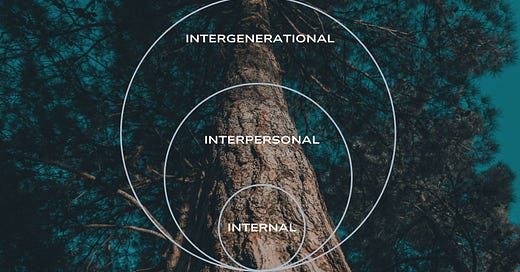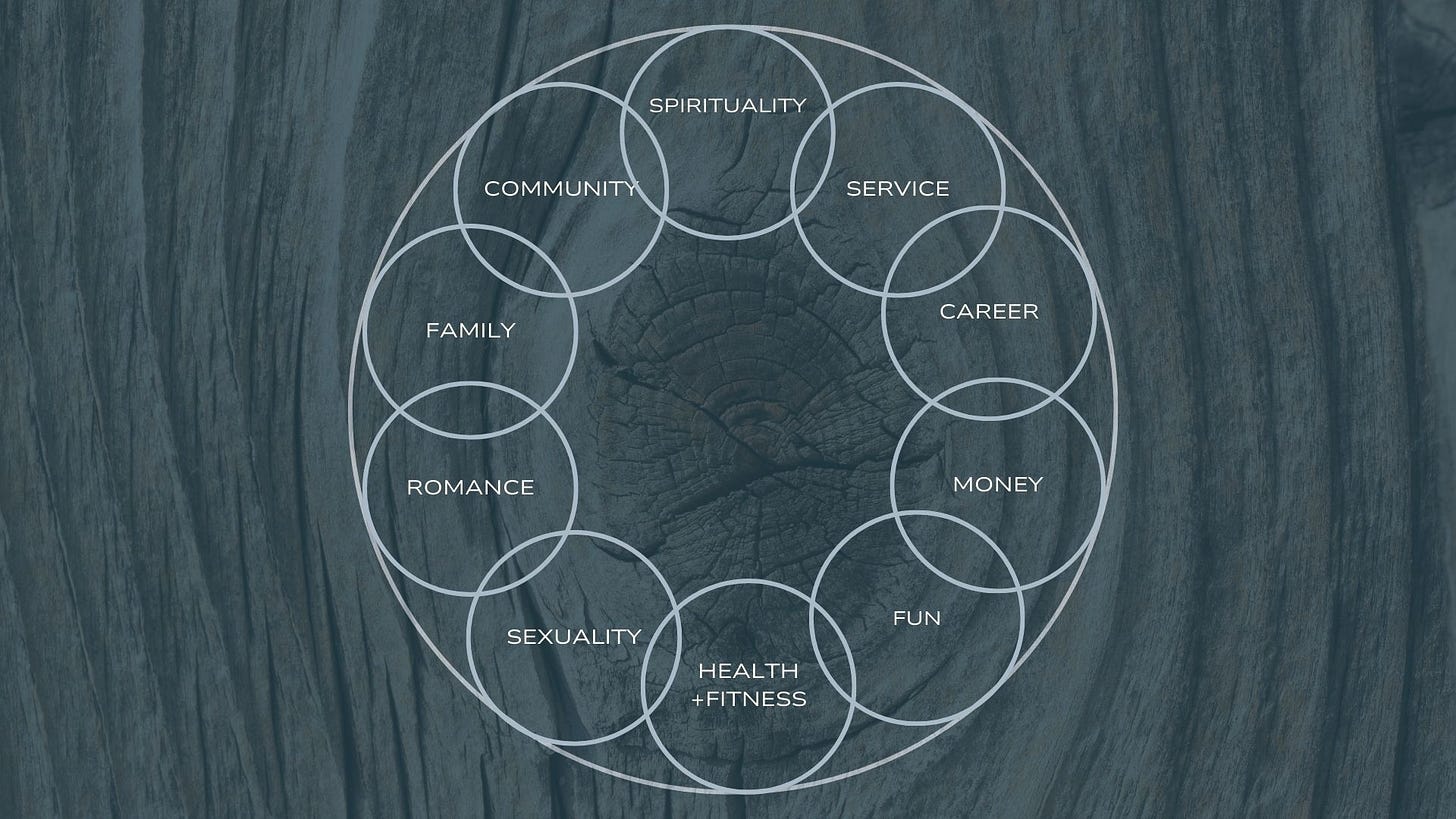Grow Like a Tree, Not Like a Cancer
From economics to biohacking, one-dimensional growth is not the only way.
For years I’ve been exploring how humanity’s obsession with perpetual growth mirrors the destructive nature of cancer. This exploration led me down a path of co-developing different theories of change, seeking ways to counteract this cancerous mindset.
Along the way, I discovered that I’m in good company in this inquiry. Edward Abbey, the environmental philosopher and author, famously wrote, “Growth for the sake of growth is the ideology of the cancer cell.” His words echo the patterns I’d observed in both societal systems and individual lives. This idea was likely first planted in my mind through my early readings of Joanna Macy, who describes our current era as “late-stage capitalism”—an unsustainable system focused on expansion without concern for the destruction it leaves in its wake.
I am personally very interested in how these institutional dynamics play out and are reproduced in our internal, interpersonal, and intergenerational patterns. This is an inquiry that my husband and I are in constant co-development and inquiry around.
As my partner, Seth Kaufmann and I have reflected on patterns we see in the many different communities and industries we belong to, and we’ve both seen firsthand how this obsession with one dimensional growth manifests in people’s lives:
Consider the husband who is so focused on breadwinning for the family that his wife and children leave him because he’s completely unavailable emotionally, practically, and physically.
Or the spiritual seeker who dives so deeply into their chosen path that they develop spiritual narcissism and become intolerable to the people who know and love them.
Or the biohacker so focused on getting the strongest, sexiest, most fit body from a fantasy that that will attract their dream partner that they lose the skill of deep presence and listening.
We see this in those who become addicted to self-improvement, hopping from one plant medicine ceremony to the next, bouncing between high vibration communities and trainings, always seeking the next level.
What if we approached our growth process the way that all healthy living systems grow? Multidimensionally, ecosystemically, in many directions, with phases for stabilizing, integrating, and rest?
This is the essence of the work Seth and I do. We bring to our clients a regenerative, multidimensional approach to growth that includes not just the self, but also the people, communities, and ecosystems that nurture us. We work with three dimensions of self: the internal, the interpersonal, and the intergenerational.
To bring this beyond theory and into practical embodiment, Seth will contribute his perspectives throughout this essay. I see firsthand how his clients experience truly multidimensional transformations, and it’s this kind of growth that inspired this essay.
The Dangers of One-Dimensional Growth
Seth and I work with clients who have experienced the fallout of one-dimensional growth. They’ve become so focused on excelling in one area—whether it’s fitness, career success, or personal transformation—that they’ve unintentionally created rifts in their relationships. This is what happens when growth becomes uncontrolled and harmful. Like cancer, it overtakes the environment and damages the very ecosystem that sustains it.
We must ask ourselves: In what ways does our singular focus on growth harm the people and connections that sustain us? What if, instead, we approached growth from a multidimensional perspective—one that considers how our personal growth impacts those we love and the communities we live in?
Seth: A huge lesson I’ve learned from Ganga Devi’s regenerative work over the years is that sometimes, it’s about pruning—letting go of old patterns, habits, or beliefs that are no longer serving you. Pruning is essential because without it, the tree becomes overgrown and unbalanced.
In our lives, pruning might mean letting go of unhealthy relationships, old ways of thinking, or routines and regimens that aren’t working anymore. We do this not only through making conscious choice, but working at the level of psychosomatic patterns that are keeping you stuck, and releasing them.
This is essential in regeneration. You compost what no longer serves, and in doing so, you make space for new growth—growth that’s healthier, more intentional, and aligned with who you are now and who you are becoming.
Our intention in developing this piece is that it might help you to consciously prune and compost any beliefs or strategies within your own life in which you may still be approaching growth as a one-dimensional endeavor.
Growing in All Directions
One of the most remarkable things about trees is their ability to grow in all directions simultaneously. They don’t just stretch upward, reaching for the sun, which is the most obvious form of growth we can see. They expand outward, building their trunks and branches, and they root deeply, establishing a strong foundation to support their height and breadth. This multidirectional growth is vital for their health and resilience.
Trees grow steadily—widening their trunks, deepening their roots, and expanding their branches, all at once. This is what makes them so strong. It’s not just about growing taller or producing more leaves; they’re stabilizing as they grow, grounding themselves deeper into the earth while reaching higher toward the sky. Without this balance of upward, downward, and outward growth, trees would either topple from weak roots or fail to thrive with limited height.
This principle of multidirectional growth applies to our lives as well. Like trees, we need to grow in all directions—wide, tall, and deep. We need to expand our relationships and connections (our outward growth), reach for higher goals and aspirations (our upward growth), and at the same time, ground ourselves by healing from the past and creating strong foundations (our deep-rooted growth).
Seth: When you take the time to honestly assess how you’re doing in multiple dimensions of your life, the clarity that follows is unavoidable. You can’t help but begin to make strategic changes to improve the whole system. I begin this way with all of my clients because it provides a baseline from which we approach your growth to ensure you’re truly well rounded. Feeling solid in career, money, and fitness but struggling with sex and spirituality? Great, it gives us focus and clarity. With this approach, we see how all dimensions are connected, and it’s easy to make subtle shifts in daily rituals and routines that help benefit multiple dimensions at once.
Stabilize and Expand
Trees grow in all directions because they have natural cycles of stabilization and expansion. They root deeply, establishing a strong foundation before stretching upward. This balance of stability and change is essential to all living systems and is reflected in systems theory as fließgleichgewicht, or flux equilibrium—a state where stability and transformation coexist to support life.
This cyclical growth applies not only to trees but to our bodies and lives as well. Just as trees require periods of rest to gather strength before expanding, our bodies and minds need time to recalibrate and integrate. In fitness, for example, constant effort without recovery leads to burnout or injury. True progress requires honoring the cycle of growth and stabilization.
Seth: In fitness culture, we often see this obsession with constant growth and improvement—more reps, faster times, bigger muscles. It’s the same cancerous mindset, and it’s actually completely contradicted by the science. What we need is a regenerative approach to fitness, and to all areas of life.
The body, like all living systems, requires periods of rest, stabilization, and recovery. If you’re constantly pushing yourself to grow without giving your body the time to stabilize, you’ll burn out, get injured, and ultimately lose the balance you need to thrive. Regenerative fitness is about honoring those natural cycles—growing, then stabilizing, and then growing again. It’s about becoming stronger and more resilient over time, without sacrificing your long-term well-being for short-term gains.
When approached this way, the inputs, routines, and rituals we create for our fitness, health, and wellbeing become tools of greater connection and cultivation. They support the development of our consciousness and our ability to live a life of true intimacy and integrity.
Each year, trees go through seasons of growth and rest. In the spring and summer, they expand; in the fall and winter, they stabilize, conserving energy and preparing for the next cycle of growth. When we slice a tree, the rings reveal this story of steady, balanced growth. These rings are circular, of course, because trees grow in all directions at once.
Seth: One of the concepts I bring into our work is called periodization. Periodization comes from the world of exercise science, where it’s used to structure an athlete’s training into cycles of work, rest, and recalibration. Originally developed by Eastern European sports scientists to maximize athlete performance, periodization breaks down goals into smaller, manageable phases—each with its own focus—allowing athletes to peak at the right moment without burning out.
But periodization isn’t just useful for physical training. It’s applicable to all areas of life. I apply this framework to help people align their goals across multiple dimensions—physical, emotional, relational, and even spiritual. Whether you’re working on building a business, strengthening your relationships, or improving your fitness, periodization helps you stay focused, avoid overwhelm, and create sustainable progress. When you’re clear on your goals, periodization becomes essential for success, helping you balance growth with recovery and focus with reflection.
And of course the multidimensional growth of trees is not just horizontal, as seen in the rings of their trunks, but also vertical—growing both deep into the earth and high into the sky. This mirrors how we, too, must grow in all directions: healing from the past (our roots), stabilizing in the present, and expanding into the future (our upward growth).
This is how we believe we are meant to grow—like trees, not cancer. In cycles of expansion and stabilization. In a way that contributes to the health of our personal ecosystems, rather than depleting them.
Whole-System Benefits
True regeneration requires a holistic view of growth beyond one singular metric. It’s about how we nurture the entire ecosystem of our lives. When trees grow, they don’t just do it for themselves—they give back in countless ways, enriching the soil, providing oxygen, offering shade, and supporting countless other species.
Our personal growth should be no different. We should aim to grow in a way that benefits not only ourselves but our communities, relationships, and the environment around us.
Seth: Growth isn’t just about what you can achieve for yourself. It’s about how your growth impacts the people around you, your relationships, and even future generations. True well-being includes internal, interpersonal, and intergenerational dimensions. Just as trees support entire ecosystems, we can grow in a way that uplifts everyone connected to us. This kind of growth—where we expand and stabilize in all dimensions—leads to lasting fulfillment and a life in which everyone thrives.
We can choose to grow like trees— in all directions, stabilizing, expanding, giving back, and regenerating. Growth doesn’t have to be about relentless optimization or self-improvement for the sake of it. It can be about flourishing in balance with the world around us, contributing to the ecosystems of our bodies, relationships, and communities.
This morning we read this poem by Nikita Gill to one another, slowly and out loud. We welcome you to do the same:
Every Day
Is not an opportunity to improve yourself.
Some days are just there for you to accept yourself
and look at the clouds.
This too is growth.
This too is rising.
The flowers do it everyday
and make the world more beautiful
just by being there.
So do you.
Rest today.
There is tomorrow.
– Nitika Gill
This poem reminds us, there are days for growing and days for simply being. Growth, like life, is cyclical, and on some days, resting and accepting ourselves is just as important as striving for more.
We hope that whatever your growth trajectory, that it be dynamic, multidimensional, integrative, and most of all, that it supports the thriving of not only you as an individual, but everyone you love.
We’d love to hear your thoughts on this topic through the comments below, and we have been loving connecting with those of you who have been reaching out directly to us. We’ve begun some incredibly rich coaching relationships through people we’ve connected with here on Substack. The depth that is possible through relationships begun here is powerful, and we look forward to connecting with more of you.
You can connect with Seth via his website here. Seth thrives when connecting with people, so he offers 30 minute discovery calls, totally free, for anyone interested in exploring working together. His passion is helping people get the right support for them, which may or may not be working with him, so don’t expect a hard sell, just a clarifying conversation with someone who wants the best for you.
I don’t offer discovery calls, but I have recently begun offering Regenerative Development Consultation sessions for people interested in regenerative development either personally or professionally. You can book that here.










